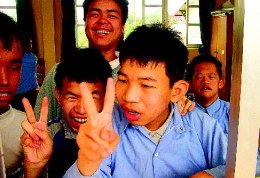The use of chemical agents during the Vietnam War is still affecting untold numbers across the country today. Justin Frewen highlights their plight
In 1975, the victorious Viet Minh entered Saigon, the capital of what was then South Vietnam, following a 30-year struggle against a range of international forces. For the first time since its occupation by France in the late 19th century, Vietnam was an independent nation, and no longer subject to the dictates of foreign powers.
However, while the lengthy and costly conflicts – which had resulted in the loss of three million Vietnamese lives – were over, they had left in their wake a legacy of obstacles to the country’s future economic development.
Vietnam had been subjected to an aerial bombardment three to four times greater than the total tonnage released during the Second World War, but it was the use of chemical defoliants which has had the greater long-term impact on the country and its people. These chemicals were employed by the US military to strip away the omnipresent lush and abundant forests in the south and centre of the country so that the Vietnamese resistance could be better targeted.
While many defoliants were used, it was the combination of the incendiary napalm used to kill trees and vegetation, and then Agent Orange to burn them prior to their removal by bulldozers, which has had the most significant long-term consequences.
Named after the orange strips on its container barrels, Agent Orange was a highly toxic herbicide. In eight years, from 1962 to 1970, 1.4 billion hectares of land and forest – approximately 12 per cent of Vietnam’s total land area – were sprayed with 80 million litres of this chemical. As a result, up to 4.8 million people were exposed to the lethal effects of dioxins – essential components of the Agent Orange compound.
Although the Vietnamese tried to protect themselves from the fallout of Agent Orange, by covering their faces with towels drenched in water or even their own urine, many were directly contaminated.
After it fell, the dioxins in Agent Orange also took root in the land and waters around, entering into the food chain of the local plants, fish, animals and people. On top of this, many barrels of the chemical remain buried in the ground, and there have been numerous accidental spillages, including the seepage of 22,000 litres of Agent Orange into a lake beside Biên Hòa, a town of some 20,000 people. Tests have shown this area to be contaminated to a level 1,000 times that considered acceptable in the United States.
At a more personal level, families with relatives disabled by exposure to Agent Orange exist in an extremely precarious economic situation. In a country which was virtually destroyed by war and further enfeebled by the post-war embargo led by the US, it is exceedingly difficult to provide the required care and attention for disabled family members.
The 2002 documentary Battle’s Poison Cloud introduces us to several of these families. In one scene we meet Nguyên C?nh, whose granddaughter, an Agent Orange victim, has virtually no control over her limbs. At every meal C?nh must first chew her granddaughter’s food until it is sufficiently soft for her to swallow.
C?nh worries for her family’s future after her passing as her granddaughter will have no one to look after her, with her daughter-in-law having to work hard in the rice fields to provide for their family.
Research carried out by the US Institute of Medicine (IOM) in 1994 and 1996 described the presence of 10 diseases that could be linked to Agent Orange. Four of these diseases had “sufficient evidence” while the remaining six bore limited evidence of “an association between exposure to herbicides”.
Based on these reports, then US President Bill Clinton approved compensation for those US personnel who had served in Vietnam and their children should they become afflicted by any of the diseases described in the IOM’s reports. However, no mention was made of Agent Orange’s victims in Vietnam.
A 2003 IOM report emphasised the possibility of undertaking extensive epidemiological research to examine the connections between herbicide use in Vietnam and the health of Vietnamese citizens and US veterans. However, IOM’s call to the US government under President George W Bush to fund such studies proved unsuccessful.
In January 2004, a case was initiated in the New York courts by the Vietnam Association for Victims of Agent Orange/Diox-in (Vava) and five individual victims to obtain compensation for the victims of Agent Orange. Their case was rejected in March 2005, with the judge ruling there was no prohibition on the use of herbicides in international law. An appeal launched on 30 September 2005 was also recently rejected.
In the meantime, thousands of people disabled by Agent Orange continue to struggle with their disabilities without the economic resources they need to make their lives more bearable. However, they are not alone in their efforts, as organisations located in Vietnam, the US, UK and many other countries are also working to obtain justice for the victims of Agent Orange.
If you too might be interested in finding out more about Agent Orange, its consequences and the ongoing efforts to obtain redress for its victims, please visit the website of the Britain-Vietnam Friendship Society at www.lenaldis.co.uk.
Justin Frewen has worked for the United Nations Office for Project Services since 1997 in Asia, Africa, the United States and the Middle East. He is currently researching for a PhD in Politics at University College Galway












